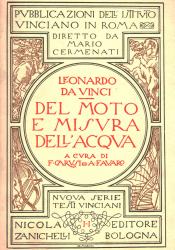Del moto e misura dell’acqua is published
Del moto e misura dell’acqua (The Motion and Measurement of Water) is a collection of transcriptions written by Leonardo da Vinci. The collection is estimated by historians to have been written around 1500, however, Leonardo did not share his collection with his peers or the general public during his lifetime (Graf 11). Over 100 years after Leonardo’s death, in 1643, the collection of original writings were compiled and transcribed by Luigi Maria Arconati (Farago “Fabrication” 579). Luigi Maria Arconati was the illegitimate son of Count Galeazzo Maria Arconati. Count Arconati was a feudal lord of the parish church of Dairago, which was the church of the archdiocese of Milan (Farago “Overview” 82). Count Arconati had amassed a large collection of Leonardo’s manuscripts, including the Codex Atlanticus and the Codex Trivulzianus (Pooler 124). Luigi Maria and Count Galeazzo worked to compile and copy the texts for use by scholars and patrons, such as Cassiano dal Pozzo and Cardinal Francesco Barberini (Farago “Overview” 82).
Among these manuscripts that were compiled by Luigi Maria was Del moto e misura dell’acqua, which is a collection of apographs of hundreds of passages that Leonardo da Vinci wrote about water. The work contains nine books, which include titles such as “della sfera dell'acqua” (On the water sphere), “del moto dell'acqua” (On the water motion), “dell'onda dell'acqua” (On the water wave), and “Dei retrosi dell’acqua” (On water vortexes) (Graf 11). While there was an attempt to compartmentalize the works on da Vinci’s behalf, the ideas were sporadic and multifaceted.
Leonardo was very interested in the interconnections between water and life. He was interested in how water could be facilitated for human benefit as well as how water interconnects with the human condition. For example, in Del moto e misura dell’acqua, Leonardo ponders the relationship between blood and water, describing that a “pool of blood veins have their origin, which ramify all over the human body, so likewise the ocean sea fills the body of the earth with infinite springs of water” (da Vinci and Richter). However, beyond just romanticizing water’s importance, da Vinci looked to understand and harness its potential. For example, within the text, da Vinci describes an experiment he performed in which he hung an old cloth equally low in a bowl of salt water and a bowl of fresh water. He found that the fresh water crept up the cloth at a more rapid rate. The explanation that Leonardo gave for this phenomenon was that the salt water had a greater density than that of fresh water (da Vinci and Richter). However, what was more fascinating than this phenomenon was that Leonardo was constructing experiments and hypothesizing at a molecular scale over 500 years ago.
Citations:
Da Vinci, Leonardo, and Jean Paul Richter. The Complete Notebooks of Leonardo Da Vinci. Eternal Sun Books, 2016, pp 372-390.
Farago, Claire J. The Fabrication of Leonardo Da Vinci's Trattato Della Pittura. Brill, 2018, pp 579.
Farago, Claire J. An Overview of Leonardo's Career and Projects Until c. 1500. Garland, 1999, pp 73-82.
Graf, Walter H. Hydraulics of Sediment Transport. Water Resources Publications, 2010, pp 11-12.
Pooler, Richard Shaw. Leonardo Da Vinci's Treatise of Painting: The Story of the World's Greatest Treatise on Painting, Its Origins, History, Content and Influence. Vernon Press, 2014.
Image:
Vinci, Leonardo da. “Of the Motion and Measure of Water.” Di Mano in Mano, Zanichelli, 1 Jan. 1983, www.dimanoinmano.it/en/cp133155/scienze/fisica/del-moto-e-misura-dell-acqua.

